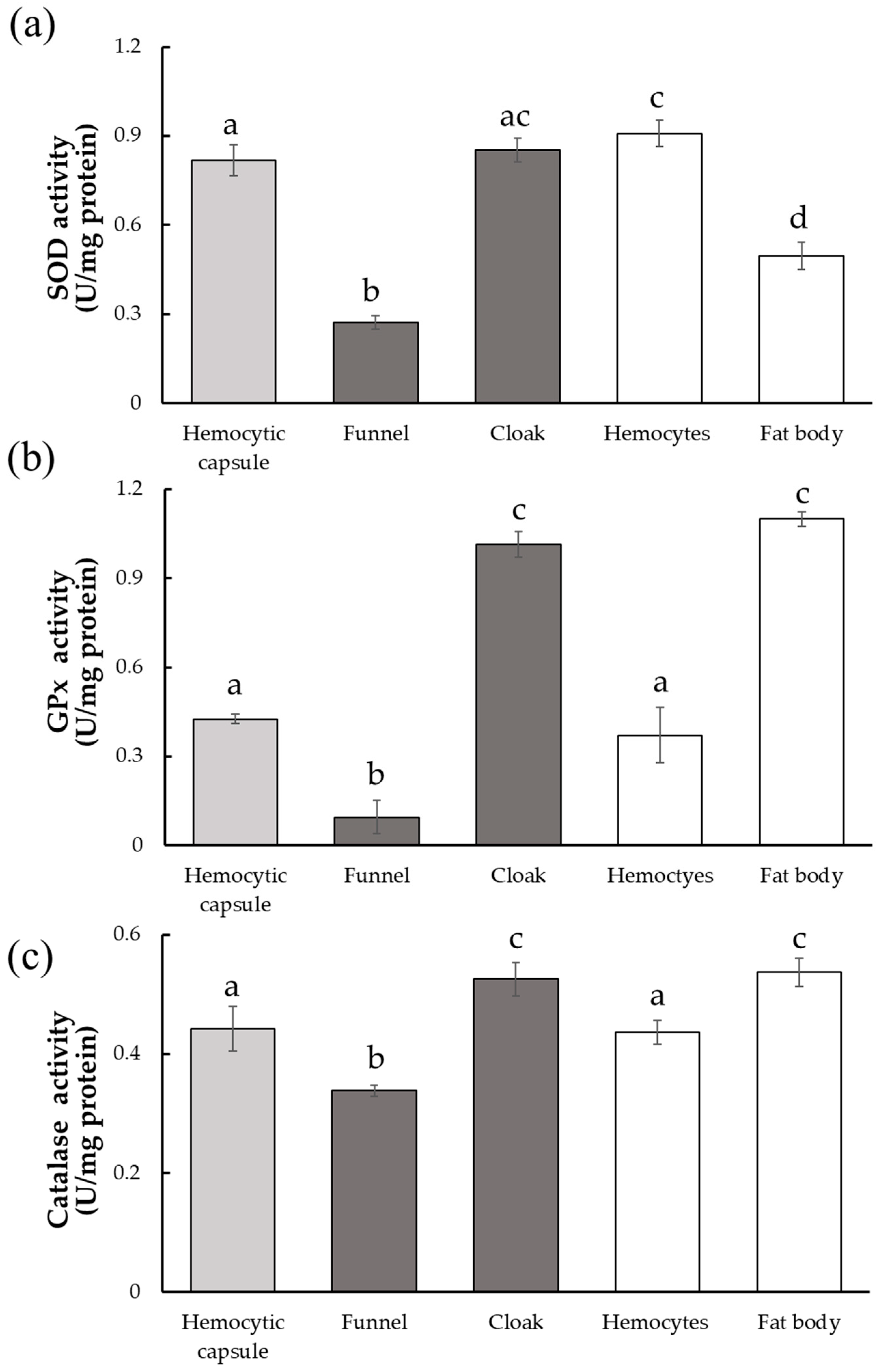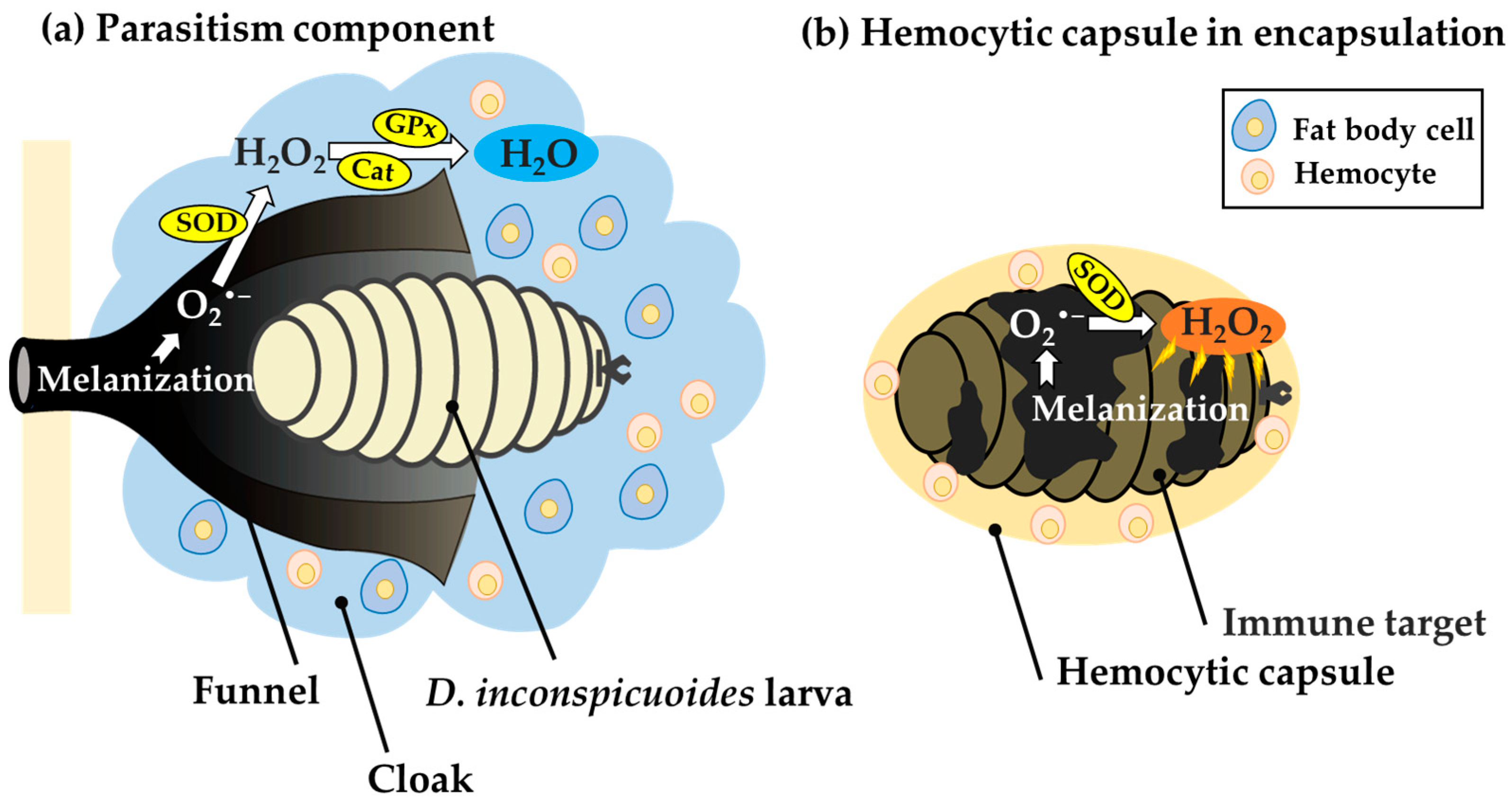Cloak Scavenges the Reactive Oxygen Species around the Larvae of Drino inconspicuoides (Diptera: Tachinidae)
Abstract
Simple Summary
Abstract
1. Introduction
2. Materials and Methods
2.1. Insect Rearing
2.2. Sample Collection
2.3. Measurement of PO Activity
2.4. Measurement of ROS Content
2.5. Antioxidant Enzyme Assay
2.6. Statistical Analysis
3. Results
3.1. Melanization of the Funnel around D. inconspicuoides Larva
3.2. Production of ROS in the Funnel around D. inconspicuoides Larvae
3.3. Activities of Three Antioxidant Enzymes in the Cloak
4. Discussion
Author Contributions
Funding
Data Availability Statement
Acknowledgments
Conflicts of Interest
References
- Stireman, J.O., III; Cerretti, P.; O’Hara, J.E.; Blaschke, J.D.; Moulton, J.K. Molecular phylogeny and evolution of world Tachinidae (Diptera). Mol. Phylogenet. Evol. 2019, 139, 106358. [Google Scholar] [CrossRef] [PubMed]
- Dindo, M.L. Tachinid parasitoids: Are they to be considered as koinobionts? BioControl 2011, 56, 249–255. [Google Scholar] [CrossRef]
- Irwin, M.E.; Schlinger, E.I.; Thompson, F.C. Diptera, True Flies. In The Natural History of Madagascar; Goodman, S.M., Benstead, J.P., Eds.; University of Chicago Press: Chicago, IL, USA, 2003; pp. 692–702. [Google Scholar]
- Stireman, J.O., III; Singer, M.S. Determinants of parasitoid–host associations: Insights from a natural tachinid–lepidopteran community. Ecology 2003, 84, 296–310. [Google Scholar] [CrossRef]
- Jiang, X.; Zhang, L.; Yang, H.; Sappington, T.W.; Cheng, Y. Biocontrol of the oriental armyworm, Mythimna separata, by the tachinid fly Exorista civilis is synergized by Cry1Ab protoxin. Sci. Rep. 2016, 6, 26873. [Google Scholar] [CrossRef]
- Cherry, A.; Cock, M.; van den Berg, H.; Kfir, R. Biological control of Helicoverpa armigera in Africa. In Biological Ontrol in IPM Systems in Africa; CAB International: Wallingford, UK, 2003; pp. 329–346. [Google Scholar]
- Broadley, H.J.; Kelly, E.A.; Elkinton, J.S.; Kula, R.R.; Boettner, G.H. Identification and impact of hyperparasitoids and predators affecting Cyzenis albicans (Tachinidae), a recently introduced biological control agent of winter moth (Operophtera brumata L.) in the northeastern USA. Biol. Control 2018, 121, 99–108. [Google Scholar] [CrossRef]
- Shima, H. A host-parasite catalog of Tachinidae (Diptera) of Japan. Makunagi/Acta Dipterol. 2006, 31, 1–108. [Google Scholar]
- Kalyebi, A.; Nakamura, S. The biology of the parasitoid fly Drino inconspicuoides (Diptera: Tachinidae) in the host Mythimna separata (Lepidoptera: Noctuidae). Appl. Entomol. Zool. 2006, 41, 365–370. [Google Scholar] [CrossRef]
- Baranov, N. Messages about gezucktete oriental larvaevoriden (Insecta: Diptera). Entomol. Nachr. 1934, 8, 41–49. [Google Scholar]
- Yang, L.; Qiu, L.M.; Fang, Q.; Stanley, D.W.; Ye, G.Y. Cellular and humoral immune interactions between Drosophila and its parasitoids. Insect Sci. 2021, 28, 1208–1227. [Google Scholar] [CrossRef]
- Lavine, M.D.; Strand, M.R. Insect hemocytes and their role in cellular immune responses. Insect Biochem. Mol. Biol. 2002, 32, 1237–1242. [Google Scholar] [CrossRef]
- Strand, M.R. The insect cellular immune response. Insect Sci. 2008, 15, 1–14. [Google Scholar] [CrossRef]
- Ratner, S.; Vinson, S.B. Phagocytosis and encapsulation: Cellular immune responses in arthropoda. Am. Zool. 1983, 23, 185–194. [Google Scholar] [CrossRef]
- Ratcliffe, N.A.; Gagen, S.J. Studies on the in vivo cellular reactions of insects: An ultrastructural analysis of nodule formation in Galleria mellonella. Tissue Cell 1977, 9, 73–85. [Google Scholar] [CrossRef]
- Boucias, D.G.; Pendland, J.C. Insect Immune Defense System, Part III: Prophenoloxidase cascade and post-attachment processes of phagocytosis. In Principles of Insect Pathology; Springer: Boston, MA, USA, 1998; pp. 499–537. [Google Scholar]
- Dubovskiy, I.M.; Kryukova, N.A.; Glupov, V.V.; Ratcliffe, N.A. Encapsulation and nodulation in insects. Invertebr. Surviv. J. 2016, 13, 229–246. [Google Scholar] [CrossRef]
- Liu, Y.T.; Chang, C.I.; Hseu, J.R.; Liu, K.F.; Tsai, J.M. Immune responses of prophenoloxidase and cytosolic manganese superoxide dismutase in the freshwater crayfish Cherax quadricarinatus against a virus and bacterium. Mol. Immunol. 2013, 56, 72–80. [Google Scholar] [CrossRef]
- Nappi, A.J.; Christensen, B.M. Melanogenesis and associated cytotoxic reactions: Applications to insect innate immunity. Insect Biochem. Mol. Biol. 2005, 35, 443–459. [Google Scholar] [CrossRef]
- Komarov, D.A.; Slepneva, I.A.; Dubovskii, I.M.; Grizanova, E.V.; Khramtsov, V.V.; Glupov, V.V. Generation of superoxide radical and hydrogen peroxide in insect hemolymph in the course of immune response. Dokl. Biol. Sci. 2006, 411, 482–485. [Google Scholar] [CrossRef]
- Whitten, M.M.; Ratcliffe, N.A. In vitro superoxide activity in the haemolymph of the West Indian leaf cockroach, Blaberus discoidalis. J. Insect Physiol. 1999, 45, 667–675. [Google Scholar] [CrossRef]
- Collin, F. Chemical basis of reactive oxygen species reactivity and involvement in neurodegenerative diseases. Int. J. Mol. Sci. 2019, 20, 2407. [Google Scholar] [CrossRef] [PubMed]
- Nappi, A.J.; Vass, E.; Frey, F.; Carton, Y. Superoxide anion generation in Drosophila during melanotic encapsulation of parasites. Eur. J. Cell Biol. 1995, 68, 450–456. [Google Scholar]
- Dubovskii, I.M.; Grizanova, E.V.; Chertkova, E.A.; Slepneva, I.A.; Komarov, D.A.; Vorontsova, Y.L.; Glupov, V.V. Generation of reactive oxygen species and activity of antioxidants in hemolymph of the moth larvae Galleria mellonella (L.) (Lepidoptera: Piralidae) at development of the process of encapsulation. J. Evol. Biochem. Physiol. 2010, 46, 35–43. [Google Scholar] [CrossRef]
- Nappi, A.J.; Vass, E. Melanogenesis and the generation of cytotoxic molecules during insect cellular immune reactions. Pigm. Cell Res. 1993, 6, 117–126. [Google Scholar] [CrossRef]
- Stireman, J.O., III; O’Hara, J.E.; Wood, D.M. Tachinidae: Evolution, behavior, and ecology. Annu. Rev. Entomol. 2006, 51, 525–555. [Google Scholar] [CrossRef] [PubMed]
- Salt, G. The resistance of insect parasitoids to the defense reactions of their hosts. Biol. Rev. 1968, 43, 200–232. [Google Scholar] [CrossRef] [PubMed]
- Michalková, V.; Valigurová, A.; Dindo, M.L.; Vanhara, J. Larval morphology and anatomy of the parasitoid Exorista larvarum (Diptera: Tachinidae), with an emphasis on cephalopharyngeal skeleton and digestive tract. J. Parasitol. 2009, 95, 544–554. [Google Scholar] [CrossRef]
- Valigurová, A.; Michalková, V.; Koník, P.; Dindo, M.L.; Gelnar, M.; Vaňhara, J. Penetration and encapsulation of the larval endoparasitoid Exorista larvarum (Diptera: Tachinidae) in the factitious host Galleria mellonella (Lepidoptera: Pyralidae). Bull. Entomol. Res. 2014, 104, 203–212. [Google Scholar] [CrossRef]
- Yamashita, K.; Zhang, K.; Ichiki, R.; Nakamura, S.; Furukawa, S. Novel host immune evasion strategy of the endoparasitoid Drino inconspicuoides. Bull. Èntomol. Res. 2019, 109, 643–648. [Google Scholar] [CrossRef]
- Takabayashi, J.; Noda, T.; Takahashi, S. Effect of kairomones in the host searching behavior of Apanteles Kariyai WATANABE (Hymenoptera: Braconidae), a parasitoid of the common armyworm, Pseudaletia Separata WALKER (Lepidoptera: Noctuidae), 1: Presence of arresting stimulants produced by the host larvae. Appl. Entomol. Zool. 1985, 20, 484–489. [Google Scholar] [CrossRef]
- Laughton, A.M.; Siva-Jothy, M.T. A standardised protocol for measuring phenoloxidase and prophenoloxidase in the honey bee, Apis mellifera. Apidologie 2010, 42, 140–149. [Google Scholar] [CrossRef]
- R Core Team. R: A Language and Environment for Statistical Computing. R Foundation for Statistical Computing; R Core Team: Vienna, Austria, 2020; Available online: https://www.R-project.org/ (accessed on 5 April 2023).
- Arrigoni, O.; De Tullio, M.C. Ascorbic acid: Much more than just an antioxidant. Biochim. Biophys. Acta. 2002, 1569, 1–9. [Google Scholar] [CrossRef]
- Felton, G.W.; Summers, C.B. Antioxidant systems in insects. Arch. Insect Biochem. Physiol. 1995, 29, 187–197. [Google Scholar] [CrossRef]
- Fridovich, I. Superoxide radical and superoxide dismutases. Annu. Rev. Biochem. 1995, 64, 97–112. [Google Scholar] [CrossRef] [PubMed]
- Ma, X.; Deng, D.; Chen, W. Inhibitors and activators of SOD, GSH-Px, and CAT. Enzym. Inhib. Act. 2017, 29, 207–224. [Google Scholar] [CrossRef]
- Valko, M.; Leibfritz, D.; Moncol, J.; Cronin, M.T.D.; Mazur, M.; Telser, J. Free radicals and antioxidants in normal physiological functions and human disease. Int. J. Biochem. Cell Biol. 2007, 39, 44–84. [Google Scholar] [CrossRef] [PubMed]
- Halliwell, B. Free radicals, reactive oxygen species and human disease: A critical evaluation with special reference to atherosclerosis. Br. J. Exp. Pathol. 1989, 70, 737–757. [Google Scholar] [PubMed]
- Sutton, H.C.; Winterbourn, C.C. On the participation of higher oxidation states of iron and copper in fenton reactions. Free Radic. Biol. Med. 1989, 6, 53–60. [Google Scholar] [CrossRef] [PubMed]
- Ward, J.F.; Evans, J.W.; Limoli, C.L.; Calabro-Jones, P.M. Radiation and hydrogen peroxide induced free radical damage to DNA. Br. J. Cancer Suppl. 1987, 8, 105–112. [Google Scholar]
- Li, H.B.; Dai, C.G.; Zhang, C.R.; He, Y.F.; Hu, Y. Cloning and expression profiling of catalase gene in the Oriental Armyworm, Mythimna separata (Lepidoptera: Noctuidae). Acta Entomol. Sin. 2018, 61, 178–187. [Google Scholar] [CrossRef]
- Li, H.B.; Dai, C.G.; He, Y.F.; Hu, Y. Characterization and expression of genes encoding superoxide dismutase in the Oriental Armyworm, Mythimna separata (Lepidoptera: Noctuidae). J. Econ. Entomol. 2019, 112, 2381–2388. [Google Scholar] [CrossRef]
- Lu, Y.; Bai, Q.; Zheng, X.; Lu, Z. Expression and enzyme activity of catalase in Chilo suppressalis (Lepidoptera: Crambidae) is responsive to environmental stresses. J. Econ. Entomol. 2017, 110, 1803–1812. [Google Scholar] [CrossRef]
- Wang, Y.; Wang, L.; Zhu, Z.; Ma, W.; Lei, C. The molecular characterization of antioxidant enzyme genes in Helicoverpa armigera adults and their involvement in response to ultraviolet—A stress. J. Insect Physiol. 2012, 58, 1250–1258. [Google Scholar] [CrossRef] [PubMed]
- Ou, J.; Deng, H.M.; Zheng, S.C.; Huang, L.H.; Feng, Q.L.; Liu, L. Transcriptomic analysis of developmental features of Bombyx mori wing disc during metamorphosis. BMC Genom. 2014, 15, 820. [Google Scholar] [CrossRef] [PubMed]
- Makwana, P.; Pradeep, A.N.; Hungund, S.P.; Ponnuvel, K.M.; Trivedy, K. The dipteran parasitoid Exorista bombycis induces pro- and anti-oxidative reactions in the silkworm Bombyx mori: Enzymatic and genetic analysis. Arch. Insect Biochem. Physiol. 2017, 94, e21373. [Google Scholar] [CrossRef] [PubMed]
- Lavine, M.D.; Beckage, N.E. Polydnaviruses: Potent mediators of host insect immune dysfunction. Parasitol. Today 1995, 11, 368–378. [Google Scholar] [CrossRef]
- Pennacchio, F.; Strand, M.R. Evolution of developmental strategies in parasitic Hymenoptera. Annu. Rev. Entomol. 2006, 51, 233–258. [Google Scholar] [CrossRef]
- Kryukova, N.A.; Dubovskiy, I.M.; Chertkova, E.A.; Vorontsova, Y.L.; Slepneva, I.A.; Glupov, V.V. The effect of Habrobracon hebetor venom on the activity of the prophenoloxidase system, the generation of reactive oxygen species and encapsulation in the haemolymph of Galleria mellonella larvae. J. Insect Physiol. 2011, 57, 796–800. [Google Scholar] [CrossRef]
- Moreau, S.J.; Asgari, S. Venom proteins from parasitoid wasps and their biological functions. Toxins 2015, 7, 2385–2412. [Google Scholar] [CrossRef]
- Teng, Z.W.; Xu, G.; Gan, S.Y.; Chen, X.; Fang, Q.; Ye, G.Y. Effects of the endoparasitoid Cotesia chilonis (Hymenoptera: Braconidae) parasitism, venom, and calyx fluid on cellular and humoral immunity of its host Chilo suppressalis (Lepidoptera: Crambidae) larvae. J. Insect Physiol. 2016, 85, 46–56. [Google Scholar] [CrossRef] [PubMed]
- Schwier, N.; Zhang, K.; Nakamura, S.; Furukawa, S. Larvae of the tachinid fly, Drino inconspicuoides (Diptera: Tachinidae), suppress melanization in host lepidopteran insects. J. Asia. Pac. Entomol. 2021, 24, 1050–1054. [Google Scholar] [CrossRef]
- Makwana, P.; Dubey, H.; Pradeep, A.N.R.; Sivaprasad, V.; Ponnuvel, K.M.; Mishra, R.K. Dipteran endoparasitoid infestation actively suppressed host defense components in hemocytes of silkworm Bombyx mori for successful parasitism. Anim. Gene 2021, 22, 200118. [Google Scholar] [CrossRef]
- Clausen, C.P. Entomophagous Insects; McGraw-Hill Book Co, Inc.: New York, NY, USA; London, UK, 1940; p. 688. [Google Scholar]
- Ichiki, R.; Shima, H. Immature life of Compsilura concinnata (Meigen) (Diptera: Tachinidae). Ann. Entomol. Soc. Am. 2003, 96, 161–167. [Google Scholar] [CrossRef]





Disclaimer/Publisher’s Note: The statements, opinions and data contained in all publications are solely those of the individual author(s) and contributor(s) and not of MDPI and/or the editor(s). MDPI and/or the editor(s) disclaim responsibility for any injury to people or property resulting from any ideas, methods, instructions or products referred to in the content. |
© 2023 by the authors. Licensee MDPI, Basel, Switzerland. This article is an open access article distributed under the terms and conditions of the Creative Commons Attribution (CC BY) license (https://creativecommons.org/licenses/by/4.0/).
Share and Cite
Zhang, K.; Nakamura, S.; Furukawa, S. Cloak Scavenges the Reactive Oxygen Species around the Larvae of Drino inconspicuoides (Diptera: Tachinidae). Insects 2023, 14, 602. https://doi.org/10.3390/insects14070602
Zhang K, Nakamura S, Furukawa S. Cloak Scavenges the Reactive Oxygen Species around the Larvae of Drino inconspicuoides (Diptera: Tachinidae). Insects. 2023; 14(7):602. https://doi.org/10.3390/insects14070602
Chicago/Turabian StyleZhang, Kai, Satoshi Nakamura, and Seiichi Furukawa. 2023. "Cloak Scavenges the Reactive Oxygen Species around the Larvae of Drino inconspicuoides (Diptera: Tachinidae)" Insects 14, no. 7: 602. https://doi.org/10.3390/insects14070602
APA StyleZhang, K., Nakamura, S., & Furukawa, S. (2023). Cloak Scavenges the Reactive Oxygen Species around the Larvae of Drino inconspicuoides (Diptera: Tachinidae). Insects, 14(7), 602. https://doi.org/10.3390/insects14070602






